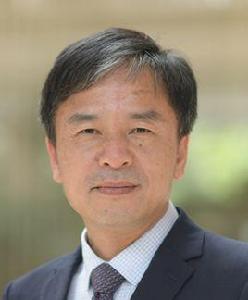個人簡歷
黃燦華教授2000年在中國科學院獲博士學位,隨後在新加坡國立大學生物系從事博士後研究。2003 年8月被新加坡國立大學腫瘤研究所聘為Research Scientist。2005年9月回國任四川大學生物治療國家重點實驗室教授。教育部“新世紀優秀人才支持計畫”獲得者(2007)。中國蛋白質組學專業委員會委員;國際學術刊物PROTEOMICS編委委員(Editorial Board 2012--)。
作為課題負責人先後承擔科技部863與973分題,衛生部新藥創製重大專項和國家自然科學基金(面上項目)等課題。回國以來以通訊作者在Mol Cell Proteomics (5篇)、Autophagy (2篇)、J Cell Sci、J Biol Chem、J Proteome Res、Proteomics、J Proteomics、Mol Cancer、Int J Cancer、Biochem Pharmacol等學術刊物上發表SCI論文30餘篇,其中半數論文影響因子大於5.0,近5年論文被引用300餘次。受邀請在MassSpectrom Rev、Expert RevProteomics (3篇)、Comb Chem High Throughput Screen等學術刊物上發表多篇關於系統生物學前沿綜述;並被聘為客座主編出版一期CombChem High Throughput Screen(2011)。受邀請在第九屆中國國際新藥創製前沿技術與產業化發展高峰論壇(2011/09青島)”;”2011南京腫瘤生物學診斷與治療進展國際研討會(2011/10 南京)”;“炎症和腫瘤相關的蛋白質研究和蛋白質組學國際研討會(2011/12 廣州)”;“第六屆亞太人類蛋白質組組織(AOHUPO)大會(2011/05 北京)”做大會特邀(主題)報告。
目前擔任四川大學華西基礎醫學與法醫學院院長 ,國家重大科學研究計畫(973計畫)“病毒誘導腫瘤發生的氧化還原蛋白質組研究”項目首席科學家(2013-2017)。國際學術刊物 Proteomics、 Signal Transduction and Targeted Therapy編委委員 。四川大學生物治療國家重點實驗室教授,四川大學華西國重創新班導師。
研究方向
(1) 系統生物學篩選藥物靶標。
(2) 病毒誘發癌變的分子機理
代表性論著
(Huang C* 為通訊作者)
1. Wang K, Yang T, Wu Q, Zhao X, Nice EC, Huang C* (2012)Chemistry-based functional proteomics for drug target deconvolution.Expert Rev ProteomicsJun 2012 (IF:4.4)
2. Zhou S, Yi T, Liu R, Bian C, Qi X, He X, Wang K, Li J, Zhao X*, HuangC*, Wei Y (2012) Proteomics identification of annexin A2 as a key mediator inthe metastasis and proangiogenesis of endometrial cells in human adenomyosis.Mol Cell Proteomics doi: 10.1074/mcp.M112.017988(IF:8.79)
3. Yuan K, Huang C*, Fox J, Weaver A, Li GP, Singh BB, Gao H, Wu M*. (2012)Autophagy plays an essential role in the clearance of Pseudomonas aeruginosa byalveolar macrophages. J Cell Sci 125:507-515 (IF: 6.3)
4. Xie N, Zhao Y, Zhang T, Huang K, Lei Y, Dong Q, Nice E, Huang C*, Wei Y.(2012) Comprehensive proteomic analysis of host cell lipid rafts modified byHBV infection. J Proteomics 75(3):725-39 (IF:5.07)
5. Lei Y, Huang K, Gao C, Lau QC, Pan H, Xie K, Li J, Liu R, Zhang T, XieN, Shan Nai H, Wu H, Zhao X, Dong Q, Nice E, Huang C*, Wei Y. (2011) Proteomicsidentification of ITGB3 as a key regulator in ROS-induced migration andinvasion of colorectal cancer cells.Mol Cell Proteomics 10(10):M110.005397(IF:8.79)
6. Yuan K, Huang C*, Fox J, Gaid M, Weaver A, Li GP, Singh BB, Gao H, WuM*. (2011) Elevated inflammatory response in Caveolin-1 deficient mice with P.aeruginosa infection is mediated by STAT3 and NF-{kappa}B. J Biol Chem.286(24):21814-25. (IF: 5.38)
7. Wang K, Liu R, Li J, Mao J, Xie N, Wu J, Lei Y, Zhang T, Zeng J, Wu H,Chen L, Huang C.* Wei Y (2011) Quercetin induces protective autophagy ingastric cancer cells: Involvement of Akt-mTOR- and hypoxia-induced factor1α-mediated signaling. Autophagy 7(9):966-78 (IF:6.83)
8. Zhou S, Li Y, Huang F, Zhang B,Yi T, Li Z, Luo H, He X, Zhong Q, BianC, Lin X, Qi X, Liu P, Huang C, Zhao X, Wei Y (2012)Live-Attenuated MeaslesVirus Vaccine Confers Cell Contact Loss and Apoptosis of Ovarian Cancer Cellsvia ROS-Induced Silencing of E-cadherin by Methylation. CancerLetters318(1):14-25 (IF:4.8)
9. Hu H,Deng C, DongQ, Yang T, Chen Y, Huang C.* , Wei Y (2011) Proteomics revisits the cancermetabolome Expert Rev Proteomics 8(4):505-33 (Invited Review) (IF:4.4)
10. Li J, Liu R, Lei Y, Wang K, Lau Q.C, Xie N, Zhou S, Nie C, Chen L, WeiY, and Huang C.* (2010) Proteomic analysis revealed association of aberrant ROSsignaling with suberoylanilide hydroxamic acid-induced autophagy in JurkatT-leukemia cells. Autophagy 17;6(6):711-24 (IF:6.83)
11. Liu R., Wang K, Yuan K, Wei Y., and Huang C.* (2010) Integrativeoncoproteomics strategies for anti-cancer drug discovery. Expert Rev Proteomics7(3):411-429(Invited Review) (IF:4.4)
12. Yuan K, Lei Y, Huang C.* (2010)Applicationof chemistry-based functional proteomics to screening for novel drug targets.Comb Chem High Throughput Screen. 13(5):414-21. (Invited Review) (IF:2.57)
13. Ren F, Wu H, Lei Y, Zhang H, Liu R, Zhao Y, Chen X, Zeng D, Tong A, ChenL, Wei Y, Huang C* (2010) Quantitative proteomics identification ofphosphoglycerate mutase 1 as a novel therapeutic target in hepatocellularcarcinoma. Mol Cancer 9:81. (IF: 5.36)
14. Liu R, Li Z, Bai S, Zhang H, Tang M, Lei Y,Chen L, Liang S, Zhao Y, Wei Y, Huang C* (2009). Mechanism of cancer celladaptation to metabolic stress: proteomics identification of a novel thyroidhormone mediated gastric carcinogenic signaling pathway. Mol Cell Proteomics2009; 8(1):70-85 (IF:9.425)
15. Li Z, Zhao X*, Bai S, Wang Z, Chen L, Wei Y, Huang C* (2008). Proteomicidentification of cyclophilin A as a potential prognostic factor andtherapeutic target in endometrial carcinoma. Mol Cell Proteomics 2008;7(10):1810-1823 (IF:9.425)
16. Wang Z, Jiang L, Huang C*, Li Z, Tong A., Chen L, Shen J, Gao F, Chen Q*(2008). Comparative proteomic approach to screening of potential diagnostic andtherapeutic targets for Oral Squamous Cell Carcinoma. Mol Cell Proteomics 2008;7:1639–1650 (IF:9.425)
17. Tong A, Gou L, Lau Q, Li J, Zhao X, Chen L, Tang H, Huang C*, and Wei Y*(2009). Proteomic Profiling Identifies Aberrant Epigenetic ModificationsInduced by Hepatitis B Virus X Protein. J Proteome Res 2009 ;8(2):1037-46(IF:5.67)
18. Tong A, Wu L, Lin Q, Lau Q, Li J, Chen L, Tang H, Huang C*, and Wei Y*(2008). Proteomic analysis of cellular protein alterations using aHBV-producing cellular model. Proteomics 8:2012-2023. (IF:5.57)
19. Li Z., Huang C.*, Bai S., Pan X., Zhou R., Wei Y., and Zhao X* (2008)Prognostic evaluation of epidermal fatty acid-binding protein and calcyphosine,two proteins implicated in endometrial cancer using a proteomic approach. Int.J. Cancer 123:2377-2383.(IF:4.55)
20. Shen J#, Huang C#, Jiang L, Gao F, Wang Z, Zhang Y, Bai J, Chen Q(2007). Enhancement of Cisplatin Induced Apoptosis by SuberoylanilideHydroxamic Acid in Human Oral Squamous Cell Carcinoma Cell lines. BiochemPharmacol 73(12):1901-1909. (IF: 4.8)

